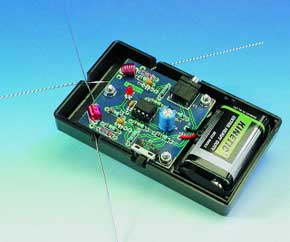Article
Mobile Phone Sniffer
track down mobile phones using this handy directional finder

In some situations and locations, the use of a mobile phone is forbidden. You may be discussing sensitive information in a closed meeting or holding important exams. How can you be sure that a concealed phone is not being used to pass information outside? Maybe you’re just curious and would like to know if someone nearby is using a phone. This neat unit will not only detect the presence of mobile phone activity (voice or text), it can home in on the culprit!If you are not familiar with the characteristic RF pulses sent out by a mobile cell phone just go over to an FM radio and switch the mobile on or off while holding it close to the radio aerial. These radio frequency (RF) pulses are an annoyance to amateur radio enthusiasts because they always seem to be picked up by sensitive input stages and you sometimes hear them on Outside Broadcast television programmes where people close to the presenter are using a mobile.
Materials
Gerber file
CAM/CAD data for the PCB referred to in this article is available as a Gerber file. Elektor GREEN and GOLD members can exclusively download these files for free as part of their membership. Gerber files allow a PCB to be produced on an appropriate device available locally, or through an online PCB manufacturing service.
Elektor recommends the Elektor PCB Service service from its business partner Eurocircuits or AISLER as the best services for its own prototypes and volume production.
The use of our Gerber files is provided under a modified Creative Commons license. Creative Commons offers authors, scientists, educators and other creatives the freedom to handle their copyright in a more free way without losing their ownership.
PCB
Component list
Resistors:
R1,R5 = 100kOhm
R2,R6 = 1kOhm
R3,R7 = 820kOhm
R4,R8 = 220Ohm
R9 = 2kOhm 2
Capacitors:
C1,C2,C3 = 100nF
C4 = 100µ F 16V radial
Inductors:
L1,L2 = 10 turns of 0.3-0.5mm diameter (30-24 SWG) enamelled copper wire, internal diameter 5mm (see text)
Semiconductors:
D1,D2 = BAT43, BAT45, AA112, AA116, AA119
D3 = LED, low-current
IC1 = LM358 P
Miscellaneous:
K1 = STEREO socket for 3.5mm jack plug, PCB mount (e.g. Conrad Electronics #732893)
S1 = on/off switch or pushbutton, 1 make contact
9-V battery (PP3) with clip-on leads
8-way IC socket
Case with battery compartment, e.g., Pactec type K-RC-24-9VB-BC (Conrad Electronics #522864)
Antennae: 2 wire pieces, length 3 to 7.5cm each (see text).
R1,R5 = 100kOhm
R2,R6 = 1kOhm
R3,R7 = 820kOhm
R4,R8 = 220Ohm
R9 = 2kOhm 2
Capacitors:
C1,C2,C3 = 100nF
C4 = 100µ F 16V radial
Inductors:
L1,L2 = 10 turns of 0.3-0.5mm diameter (30-24 SWG) enamelled copper wire, internal diameter 5mm (see text)
Semiconductors:
D1,D2 = BAT43, BAT45, AA112, AA116, AA119
D3 = LED, low-current
IC1 = LM358 P
Miscellaneous:
K1 = STEREO socket for 3.5mm jack plug, PCB mount (e.g. Conrad Electronics #732893)
S1 = on/off switch or pushbutton, 1 make contact
9-V battery (PP3) with clip-on leads
8-way IC socket
Case with battery compartment, e.g., Pactec type K-RC-24-9VB-BC (Conrad Electronics #522864)
Antennae: 2 wire pieces, length 3 to 7.5cm each (see text).



Discussion (0 comments)